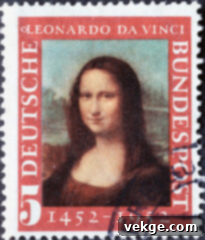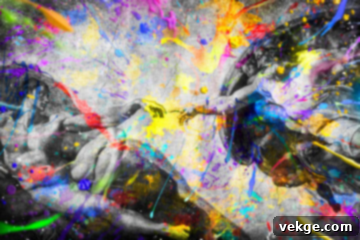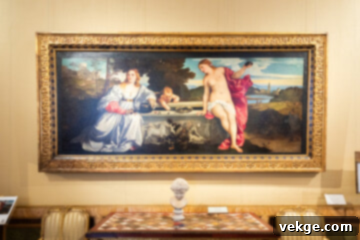From Renaissance to Pop Culture: The Enduring Influence of Iconic Artworks
Throughout human history, certain works of art have transcended their time and left an indelible mark on civilization. These masterpieces didn’t just adorn walls; they actively shaped artistic movements, dictated fashion trends, and established new standards of style and aesthetics. More profoundly, they have consistently served as a wellspring of inspiration, encouraging countless individuals across generations to embrace creative bravery and embark on new discoveries.
Every significant era has given rise to its own artistic genius—a visionary whose name and creations become timeless role models. These great artists craft unique masterpieces that resonate globally and maintain immense recognition, especially within the vibrant tapestry of modern pop culture. This article delves into some of these classic artworks and explores the profound ways they continue to influence and appear in contemporary popular culture, proving their eternal relevance.
1. Mona Lisa’s Enigmatic Face: An Icon Beyond Fine Art
Leonardo da Vinci’s “La Gioconda,” universally known as the Mona Lisa, is arguably the most famous and enigmatic artwork in the world. This captivating portrait, believed to depict Lisa Gherardini, embodies the quintessential Renaissance ideal of female beauty and grace. Its journey through history has been as dramatic as its allure, including several attempts at vandalism and a sensational theft in 1911, from which it was only recovered two years later, further cementing its legendary status. The story behind its 1911 abduction and return captivated the world, transforming the painting into a global phenomenon.

The admiration for this painting knows no bounds. Even historical figures like Napoleon Bonaparte were captivated, reportedly having it hung in his personal chambers. Its status as an unparalleled artistic achievement is underscored by its official designation as priceless, with an estimated insurance valuation reaching a staggering $3 billion. Today, the Mona Lisa draws millions of visitors annually to its home in the Louvre Museum in Paris.
Beyond the realm of fine art, the Mona Lisa’s distinctive face has evolved into a global cultural icon. Her mysterious smile and serene gaze are instantly recognizable, gracing everything from mass-produced merchandise like T-shirts and smartphone cases to high-fashion editorials and avant-garde art installations. She is frequently referenced in films, music videos, and advertisements, often serving as a shorthand for sophistication, mystery, or the very essence of art itself. Digital artists and meme creators alike continue to reimagine her image, ensuring that the Mona Lisa remains a dynamic and ever-present force in our visual culture, embodying the enduring power of famous paintings to transcend their original context.
2. The Last Supper’s Iconic Layout: A Blueprint for Modern Visuals
Leonardo da Vinci’s monumental fresco, “The Last Supper,” painted on the refectory wall of the Santa Maria delle Grazie monastery in Milan, is another cornerstone of art history with an enduring presence in contemporary culture. This masterpiece, depicting Jesus’ final meal with his apostles before his betrayal and crucifixion, has undergone at least five major restorations over its 500-year history, with the most recent extensive effort lasting an impressive 21 years. Da Vinci’s revolutionary use of perspective and his dramatic capture of the apostles’ reactions to Jesus’s announcement of betrayal create a scene of intense emotional depth and narrative power. Beyond its stunning composition, shapes, and colors, the fresco has fueled centuries of scholarly and popular speculation concerning hidden meanings, including debates about the alleged presence of Mary Magdalene alongside Jesus.
The Last Supper’s compositional brilliance—its linear perspective drawing the eye to the central figure, the symmetrical yet dynamic arrangement of figures, and the masterful portrayal of individual psychological states—has made it an unparalleled reference point in visual media. Its iconic layout has been reimagined and parodied countless times across various facets of pop culture. From movie posters and magazine covers to music album art and fashion editorials, artists and advertisers consistently draw upon its instantly recognizable structure. This formation is often utilized to visually frame celebrities, fictional characters, or brand campaigns, lending them an aura of importance, drama, or a pivotal moment. The way Da Vinci orchestrated individual expressions within a unified scene offers a timeless template for storytelling, making “The Last Supper” a pervasive, albeit often subtle, influence on how we construct and consume visual narratives today.
3. Renaissance Mythology Reimagined: The Birth of Venus & The Creation of Adam in Music Videos
The rich visual vocabulary of the Renaissance, with its emphasis on classical mythology, religious narratives, and idealized forms, continues to captivate and inspire contemporary artists, particularly in the realm of music. Pop stars frequently draw upon these ancient masterpieces to infuse their work with depth, symbolism, and a sense of timeless grandeur. This trend is vividly exemplified by how two iconic works, Sandro Botticelli’s “The Birth of Venus” and Michelangelo’s “The Creation of Adam,” have been strikingly reinterpreted in modern music videos.
The Birth of Venus: Redefining Beauty and Divinity
Sandro Botticelli’s “The Birth of Venus” is an exquisite celebration of classical beauty and mythological narrative, depicting the goddess Venus emerging from the sea on a scallop shell, driven by Zephyr, while being clothed by a Hora. This painting, with its ethereal beauty, flowing lines, and pagan subject matter, was revolutionary for its time and remains a quintessential symbol of the Italian Renaissance. It speaks to themes of divine beauty, nature, and rebirth. In 2013, Lady Gaga paid direct homage to this masterpiece in her music video for “Applause.” Adopting Venus’s iconic pose, Gaga donned long, flowing locks and a bra artfully crafted from two scallop shells, mirroring Botticelli’s depiction. This visual reference not only acknowledged the painting’s aesthetic but also allowed Gaga to playfully explore themes of performance, artistry, and the public’s perception of pop divas, drawing a parallel between classical iconography and contemporary celebrity culture.

The Creation of Adam: A Feminist Reimagining of Divine Power
Michelangelo’s “The Creation of Adam,” a segment of the Sistine Chapel ceiling fresco, is perhaps one of the most recognized and reproduced images in history. It famously depicts God reaching out to touch Adam’s finger, imbuing him with life—a powerful representation of creation, divine spark, and human potential. The iconic gesture, where two hands almost meet, symbolizes the moment of spiritual and physical awakening. Ariana Grande, throughout her musical career, has also drawn significantly from Renaissance imagery. Her powerful 2018 music video for “God is a Woman” is replete with various religious and classical allusions. The video culminates in a dramatic and strikingly feminist reproduction of Michelangelo’s early-16th-century masterwork. Grande positions herself in Adam’s place, while a diverse group of women collectively embody the divine, effectively subverting the original patriarchal narrative. This reinterpretation boldly places feminine power at the center of creation, demonstrating how classic art can be reclaimed and recontextualized to convey powerful contemporary messages about gender, divinity, and self-empowerment.
4. Lady Godiva’s Defiance: Inspiring Pop Album Covers and Feminist Statements
The profound impact of Renaissance-inspired artwork on contemporary pop culture cannot be fully appreciated without acknowledging the work of artists like Beyoncé. She has consistently incorporated powerful visual references from art history into her creative output, most notably on the cover of her critically acclaimed 2022 album, Renaissance. The album cover features Beyoncé majestically seated on a gleaming silver horse, gazing directly and powerfully at the viewer. This striking image is a modern reimagining of the legend of Lady Godiva, an Anglo-Saxon noblewoman whose story of courage and defiance dates back to the early eleventh century.
The specific visual reference for Beyoncé’s cover is a well-known Renaissance-era artwork, often attributed to artists like Adam van Noort, depicting Lady Godiva’s legendary ride. Lady Godiva became a celebrated historical figure through a legend that emerged as early as the 13th century. According to the folklore, she rode naked through the streets of Coventry, covered only by her long hair, to protest the oppressive taxes her husband, Leofric, Earl of Mercia, had imposed on his tenants. Her husband promised to reduce the debts if she undertook this humiliating act, which she did out of compassion for the suffering people.
In later versions of the story, a tailor named Thomas defied the town’s collective agreement to avert their eyes and secretly spied on Lady Godiva from his window. As a consequence, he was struck blind or lost his life—giving rise to the enduring idiom “Peeping Tom.” Lady Godiva’s story has cemented her legacy as a symbol of moral integrity, courage, and self-sacrifice. Her act of defiance in the face of injustice resonates deeply with contemporary themes of empowerment and standing up for what is right. Beyoncé’s album cover brilliantly channels this spirit, transforming a historical act of vulnerability into a powerful declaration of feminine strength and regal autonomy, thereby affirming Lady Godiva’s continued relevance as a potent symbol of feminine authority and resistance in modern society.
5. Sacred and Profane Love: Echoing Duality in Pop and Fashion Culture
Titian’s masterpiece, now famously known as “Sacred and Profane Love,” was not given its evocative title by the artist himself; rather, it acquired this name nearly two centuries after its creation. The painting’s complex composition and allegorical depth have long fueled scholarly debate, but it is widely believed to have been commissioned as a wedding gift for the Venetian aristocrat Niccolò Aurelio and his bride, Laura Bagarotto. The artwork features two female figures: one sumptuously dressed in a white bridal gown, representing earthly or married love, and the other nude, symbolizing heavenly or spiritual love. They are seated on the edge of a classical sarcophagus that serves as a fountain, amidst a rich, symbolic landscape.

The backdrop itself is rich with symbolism: a winding uphill road suggests prudence and fidelity in marriage, while the serene plain signifies mutual understanding and peace. The presence of rabbits traditionally symbolizes fertility, reinforcing the themes of marital union and progeny. A small putto stirring water in the fountain further adds to the rich allegorical layers. This profound artwork, alongside other magnificent masterpieces, is housed in the prestigious Galleria Borghese in Rome, continuing to inspire awe and contemplation.
The timeless themes of duality, sensuality, and purity explored in “Sacred and Profane Love” resonate profoundly in modern pop and fashion culture. Its sophisticated balance between the earthly and the divine, the material and the spiritual, offers a rich wellspring for contemporary aesthetics. This artistic duality has influenced modern wedding designs, inspiring themes that blend opulence with natural beauty. Luxury branding often employs similar juxtapositions to convey depth and exclusivity. Editorial photography frequently draws upon its visual language to explore complex human emotions or relationships, contrasting vulnerability with strength, or innocence with experience. The painting’s elegant interplay of draped and nude forms, and its celebration of both carnal and spiritual love, are echoed in fashion campaigns, jewelry designs, and art-inspired visual marketing across global media, demonstrating the enduring power of its message of harmonious contrast. The mysteries and interpretations of Titian’s Sacred and Profane Love continue to inspire new narratives.
Final Thoughts: The Ever-Present Echo of Masterpieces in Modern Culture
While these iconic paintings were created centuries ago, their influence remains deeply embedded in the fabric of modern pop culture. Far from being mere historical artifacts confined to museum walls, they are dynamic and living sources of inspiration, continually shaping how we perceive and interpret beauty, mystery, symbolism, and narrative. From the intricate storylines of cinematic productions and the provocative visuals of fashion editorials to the impactful designs of music album covers and the vibrant expressions of street art, masterpieces such as the Mona Lisa, The Last Supper, The Birth of Venus, The Creation of Adam, the legend of Lady Godiva, and Titian’s Sacred and Profane Love continue to resonate with contemporary audiences.
These classic artworks serve as powerful reference points in global pop culture, constantly being reinterpreted, parodied, and celebrated. Their enduring relevance is a profound testament to the timeless power of great art. They possess an unparalleled ability to inspire new creative endeavors, adapt to diverse contexts, and provoke meaningful conversations across generations and artistic mediums. In an ever-evolving cultural landscape, these masterpieces stand as steadfast anchors, reminding us that true artistic genius transcends time and continues to fuel the creative spirit of humanity.
